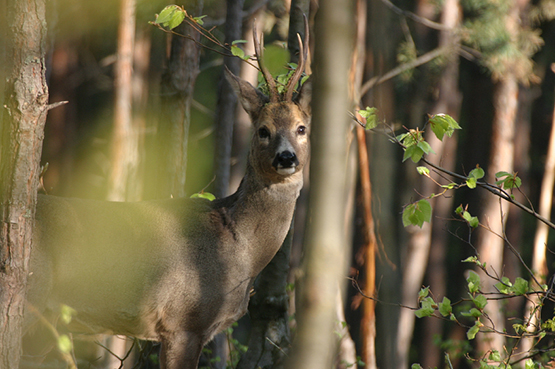It's all change in the world of deer stalking as we turn our attention to the Roe Buck. Peter Jones takes a look at the month ahead.

(Above: Mature bucks may be clean of velvet by April however the young will usually still be in tatters)
With the males of all deer species, save for the Roe buck, now beginning the process of antler casting and with the females now protected, it is to the Roe Buck that we turn.
Once again all is change in the deer stalking world, as focus shifts from the task of culling sufficient females to the more considered and leisurely pursuit of stalking and selecting the correct Roe Buck.
It is of course too early to be shooting your best males, who, even if they are devoid of velvet (this will certainly be true of the older bucks), will exhibit antlers that are pale, or even white. This is considered undesirable amongst ‘die hard’ trophy hunters, who prefer the attractive darker tones that come later in the season after the buck has spent time thrashing. Unsurprisingly this preference is also reflected by the trophy commission, who award an additional four points for black down to nil for white.
The selection at this time of year is therefore with a view to weeding out the lesser bucks on your ground, who by virtue of their more diminutive stature, will soon be sent packing by larger males that are trying to secure initial mating rights with resident females in the months to come.
In truth this puts too simplistic a spin on the art of correct selection. However it is a useful rule of thumb when deliberating over which male to shoot. In fact some young males will be tolerated in close proximity by the dominant male and others rejected. However a weeding of the young and weak is a good policy in deer management and so this rule of thumb will not serve you wrong.
As for this year’s anticipated crop of trophy heads, well personally, I have given up trying to forecast promising seasons. Yes we have had a relatively mild winter, however it strikes me that there are far too many variables on a local level that influence the breeding of a true champion, and so I will leave it to each individual deer manager to make his or her own forecasts based on what has happened on their specific plot over the preceding months.
Of course it’ll be May before the Trophy hunters set out in search of a prize and with the required three month drying time before trophies can be measured, it’ll be late summer before the first results start drifting in.
If you'd like to read more about Roe Buck selection follow this link to the following article where chief CIC judge Iain Watson discusses when to shoot your Roe Buck: when-to-shoot-that-trophy-roe-buck
On to this month’s film which I think you’ll enjoy and can be found on the Training Films page. We take a look at shooting sticks and my colleague James Mott sees just how accurately he can shoot from sticks at distance. Viewers might like to try their hand at the same test, if so then just give us a call!
 IN Season in England & Wales: Fallow Buck, Roe Buck, Sika Stags, Red Stags, Muntjac Bucks & Muntjac Does.
IN Season in England & Wales: Fallow Buck, Roe Buck, Sika Stags, Red Stags, Muntjac Bucks & Muntjac Does.
Off Season in England & Wales: Roe Does, Fallow Does, Sika Hinds, Red Hinds, CWD Bucks & CWD Does.
In Season in Scotland: Fallow Buck, Roe Buck
Off Season in Scotland: Red Stags & Red Hinds, Sika Stags & Sika Hinds, Roe Does and Fallow Does.
(Peter Jones - Editor)



















